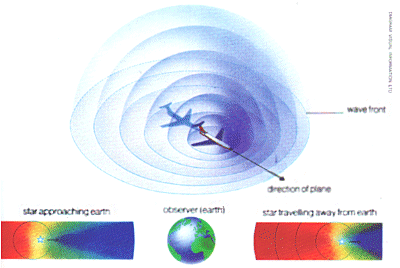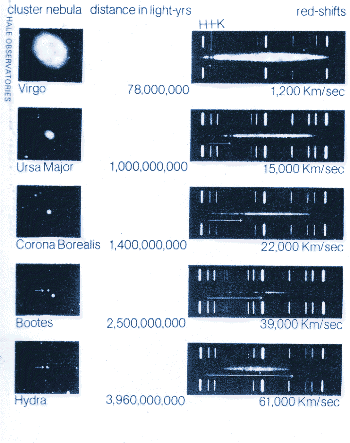
 |
How it works : Doppler Effect |
DOPPLER EFFECT
With any wave-type motion the apparent frequency-the pitch of a sound or the colour of a light is determined by the rate at which the waves pass the observer. If there is relative motion between the source and observer the apparent frequency will be altered, the frequency of wave-encounters being raised if the source and observer are moving towards each other and lowered if they are moving apart.
 |
| Above: the Doppler effect. A wave is emitted simultaneously in all directions but by the time the next wave front is released the aeroplane has moved forward, with the result the waves are compressed in front, giving a higher pitch, and attenuated to the rear for a lower pitch. A similar effect is experienced with light waves from stars. |
The effect, first investigated by Austrian physicist C J Doppler in 1842, is often evident when a moving source of sound, such as an aircraft, racing car or train (especially a train sounding a whistle or hooter) passes close to the observer. The noise approaches as a high-pitched note and swiftly falls to a much lower pitch, passing through the true pitch for the source at the point where source and observer are closest together and have instantaneously no relative motion along the line joining them.
 |
| Evidence for an expanding universe. On the left are galaxies-huge star systems each progressively smaller and fainter. On the right are their spectra, the long streaks between pairs of reference spectra produced at the telescope. The more distant the galaxy, the more the distinctive 'H' and 'K' lines, due to ionised calcium, are shifted to the red end as indicated by the arrow. The actual distances to the galaxies must be found separately, for example by detecting stars of known brightness in them. |
There are few applications of the Doppler effect with sound and similar vibrations involving matter, but in the case of ELECTROMAGNETIC RADIATION it has already been put to many uses. In 1848 Fizeau verified the validity of the concept with light, and soon astronomers began to study the spectra of stars (see SPECTROSCOPY) and discovered an apparent shift of wavelength or frequency in many of them, interpreted as indicative of motion relative to the Earth. This Doppler shift has been used to calculate stellar velocities and, in the case of orbital bodies such as binary stars, planets and planetary moons, their orbits and distances.
In the present century it was realized that the shift of what appear to be the most distant objects is towards the red end of the spectrum, this lengthening of the apparent wavelength signifying motion away from the solar system. By 1940 the red shift was accepted as strongly indicative of an expanding Universe, with the most distant visible objects receding at the highest speeds.
In the field of RADAR, Doppler effects have become enormously important. By 1950O military radars were beginning to incorporate MTI (moving target indication) by adding circuits which instantly detect reflected signals subject to a Doppler shift while ignoring reflections from fixed targets. Thus the radar could at once spot an aircraft approaching low down in front of a distant hillside. Today Doppler radars are so sensitive they can be used as BURGLAR ALARMS. A miniature aerial can 'illuminate' a courtyard or other space and signal the alarm if an intruder were to creep in at the slowest practical rate of human motion. Other Doppler radars are carried by aircraft as navigation aids, to measure relative motion between aircraft and ground (see AVIONICs) with special corrections being applied for wave motion when flying over the ocean. This principle is also used in radar speed checks on cars.
Reproduced from HOW IT WORKS p790